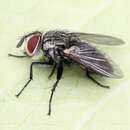mk
имиња во трошки


Compsilura concinnata (tachinid fly; order Diptera) is a parasitoid native to Europe that was introduced to North America in 1906 to control the population of an exotic forest, univoltine, spongy moth named Lymantria dispar. It is an endoparasitoid of larvae and lives with its host for most of its life. Eventually the parasitoid ends up killing the host and occasionally eating it. It attacks over 200 host species, mainly insects from the Orders: Coleoptera, Lepidoptera and Hymenoptera. Since this parasite has the ability to attack many different types of hosts, the organism has spilled over from the intended forest systems into other areas, like agricultural fields, affecting cabbage pests including the cabbage looper (Trichoplusia); the cabbage worm (Pieris rapae); and even other invasive species such as the brown-tail moth. However, it also attacks native, non-pest insects such as the Cecropia moth and American moon moth.[3][4][5]
Larvae are creamy colored and have black mouth hooks with three anal hooks. Pupae, the life stage in insects when undergoing transformation, are brown, 6.5 mm long and oval shape. Adult flies look very similar in its size/shape to the house-fly. Adults have a white face and a thorax containing four black stripes and reach up to 7.5 mm long.[3]
C. concinnata is ovoviviparous. In a year, approximately 3–4 generations occur (multivoltine) with an adult life span of 5–22 days. The parasitoid larvae typically survive winters in host larvae; so since the spongy moths overwinter as an egg, it has to find alternative hosts to overwinter in their larvae. After mating has occurred, the adult female looks for host larvae. If a host meets her satisfaction for her offspring, she attaches on the host’s back using her anal hooks, punctures the integument of the host with a piercing structure on her abdomen and injects a single larva into the host's midgut or body cavity. The female produces about 100 larvae. She will sometimes attack the same host multiple times. If she injects a larva directly into the host's body cavity, it will quickly migrate to the midgut and penetrate it where three larvae stages occur. Compsilura concinnata remains a larva for only 10–17 days while waiting for its host's pupation when it will emerge from its host to pupate on another substrate or soil.[3]
The larva typically kill its host in about 10 days. After emerging from a host, the white maggot forms a smooth, reddish brown case called a puparium around itself. During the next stage of its life cycle, the larva will molt into a pupa inside of the puparium.[6]
What makes this parasitoid successful on numerous host-species is its flexible life cycle. It has the ability to alter its cycle based on the host it inhabits.
Compsilura concinnata has a negative impact on many species of Lepidoptera native to North America.
Although C. concinnata was introduced to North America to control the spongy moth population, it typically only parasitizes less than 5% of the spongy moths during an outbreak.[10] However the percentage of infected moths does increase as the populations tend to decline. As a result of the parasitoid's ability to attack many other species, it is not always an effective parasitoid of spongy moths compared to other parasites.[10]
Compsilura concinnata (tachinid fly; order Diptera) is a parasitoid native to Europe that was introduced to North America in 1906 to control the population of an exotic forest, univoltine, spongy moth named Lymantria dispar. It is an endoparasitoid of larvae and lives with its host for most of its life. Eventually the parasitoid ends up killing the host and occasionally eating it. It attacks over 200 host species, mainly insects from the Orders: Coleoptera, Lepidoptera and Hymenoptera. Since this parasite has the ability to attack many different types of hosts, the organism has spilled over from the intended forest systems into other areas, like agricultural fields, affecting cabbage pests including the cabbage looper (Trichoplusia); the cabbage worm (Pieris rapae); and even other invasive species such as the brown-tail moth. However, it also attacks native, non-pest insects such as the Cecropia moth and American moon moth.
Compsilura concinnata adolah langau dari famili Tachinidae. Langau iko juo marupokan bagian dari ordo Diptera, kelas Insecta, filum Arthropoda, dan kingdom Animalia.
Langau iko marupokan parasit Protelean.
Compsilura concinnata adolah langau dari famili Tachinidae. Langau iko juo marupokan bagian dari ordo Diptera, kelas Insecta, filum Arthropoda, dan kingdom Animalia.
Compsilura concinnata is een vliegensoort uit de familie van de sluipvliegen (Tachinidae).[1] De wetenschappelijke naam van de soort is voor het eerst geldig gepubliceerd in 1824 door Meigen.
Bronnen, noten en/of referentiesCompsilura concinnata là một loài ruồi trong họ Tachinidae.[1][2]
Compsilura concinnata là một loài ruồi trong họ Tachinidae.